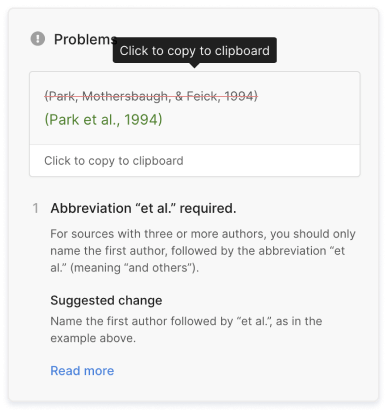The Basics of In-Text Citation | APA & MLA Examples
An in-text citation is a short acknowledgement you include whenever you quote or take information from a source in academic writing. It points the reader to the source so they can see where you got your information.
In-text citations most commonly take the form of short parenthetical statements indicating the author and publication year of the source, as well as the page number if relevant.
We also offer a free citation generator and in-depth guides to the main citation styles.
Generate accurate citations with Scribbr
Go to APA examplesGo to MLA examplesGo to Chicago examples
What are in-text citations for?
The point of an in-text citation is to show your reader where your information comes from. Including citations:
- Avoids plagiarism by acknowledging the original author’s contribution
- Allows readers to verify your claims and do follow-up research
- Shows you are engaging with the literature of your field
Academic writing is seen as an ongoing conversation among scholars, both within and between fields of study. Showing exactly how your own research draws on and interacts with existing sources is essential to keeping this conversation going.
When do you need an in-text citation?
An in-text citation should be included whenever you quote or paraphrase a source in your text.
Quoting means including the original author’s words directly in your text, usually introduced by a signal phrase. Quotes should always be cited (and indicated with quotation marks), and you should include a page number indicating where in the source the quote can be found.
Paraphrasing means putting information from a source into your own words. In-text citations are just as important here as with quotes, to avoid the impression you’re taking credit for someone else’s ideas. Include page numbers where possible, to show where the information can be found.
However, to avoid over-citation, bear in mind that some information is considered common knowledge and doesn’t need to be cited. For example, you don’t need a citation to prove that Paris is the capital city of France, and including one would be distracting.
Types of in-text citation
Different types of in-text citation are used in different citation styles. They always direct the reader to a reference list giving more complete information on each source.
Author-date citations (used in APA, Harvard, and Chicago author-date) include the author’s last name, the year of publication, and a page number when available. Author-page citations (used in MLA) are the same except that the year is not included.
Both types are divided into parenthetical and narrative citations. In a parenthetical citation, the author’s name appears in parentheses along with the rest of the information. In a narrative citation, the author’s name appears as part of your sentence, not in parentheses.
| Parenthetical citation | Narrative citation | |
|---|---|---|
| Author-date (APA) | The treatment proved highly effective (Smith, 2018, p. 11). | Smith states that the treatment was highly effective (2018, p. 11). |
| Author-page (MLA) | The treatment proved highly effective (Smith 11). | Smith states that the treatment was highly effective (11). |
Note: Footnote citations like those used in Chicago notes and bibliography are sometimes also referred to as in-text citations, but the citation itself appears in a note separate from the text.
Frequently asked questions about in-text citations
- What is an in-text citation?
-
An in-text citation is an acknowledgement you include in your text whenever you quote or paraphrase a source. It usually gives the author’s last name, the year of publication, and the page number of the relevant text. In-text citations allow the reader to look up the full source information in your reference list and see your sources for themselves.
- When do I need to cite sources?
-
At college level, you must properly cite your sources in all essays, research papers, and other academic texts (except exams and in-class exercises).
Add a citation whenever you quote, paraphrase, or summarize information or ideas from a source. You should also give full source details in a bibliography or reference list at the end of your text.
The exact format of your citations depends on which citation style you are instructed to use. The most common styles are APA, MLA, and Chicago.
- Which citation style should I use?
-
Check if your university or course guidelines specify which citation style to use. If the choice is left up to you, consider which style is most commonly used in your field.
- APA Style is the most popular citation style, widely used in the social and behavioral sciences.
- MLA style is the second most popular, used mainly in the humanities.
- Chicago notes and bibliography style is also popular in the humanities, especially history.
- Chicago author-date style tends to be used in the sciences.
Other more specialized styles exist for certain fields, such as Bluebook and OSCOLA for law.
The most important thing is to choose one style and use it consistently throughout your text.
Cite this Scribbr article
If you want to cite this source, you can copy and paste the citation or click the “Cite this Scribbr article” button to automatically add the citation to our free Citation Generator.
Caulfield, J. (2024, February 28). The Basics of In-Text Citation | APA & MLA Examples. Scribbr. Retrieved April 26, 2024, from https://www.scribbr.com/citing-sources/in-text-citation-styles/


